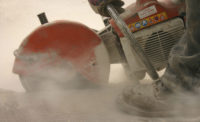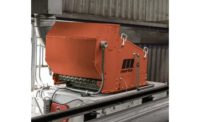Silica dust prevention for masons

There are numerous job tasks and functions throughout the construction industry that are notorious for producing massive amounts of dust. Typically these jobs involve grinding, sawing, drilling, and chiseling. For masons, the danger comes from operating on stone and concrete materials such as brick, asphalt, and mortar that contain concentrated amounts of crystalline silica. When these materials are operated on, silica containing dust is emitted and enters the workers’ breathing zone
The amount of dust that is produced or that accumulates varies depending on the task being performed and the material that the task is being performed on. Notably, concrete cutting and grinding, jackhammering, and tuck pointing are all construction tasks that are completed by masons during demolition, refurbishment, or foundational construction. This article takes a deeper look at each function and explains how dust is formed as well as how airborne dust can be eliminated to prevent masons from developing serious, life-threatening lung illnesses.
Concrete cutting & grinding
Concrete grinding and cutting are frequently used techniques in the construction industry. Masons use specialized equipment to cut concrete, asphalt, brick, and tile for industrial projects such as building construction or entryway creation. Concrete grinding often occurs when sidewalks, parking lots, roads, and highways have been overused and are in need of repair. This method of construction offers instant enhancement to the overall smoothness and safety of the concrete. When concrete is cut or ground, silica dust is released and without the proper control methods, this dust can pose serious health issues to masons.
Controls – Operate grinding and cutting tools that are equipped with an integrated water delivery system to help eliminate silica dust production. These systems continuously supply water to the concrete surface that cuts off dust production at the source. For proper implementation, employers are required to ensure the following:
- A sufficient amount of water is applied to the surface for dust suppression
- Spray nozzles are not congested or defective and are applying water at the point of dust conception
- All hoses and connections from water source are intact
For masons who are grinding specifically, a grinder with a shroud and commercial dust collection system should be provided to minimize secretions of dust. Dust collection systems should be used for both indoor and outdoor grinding operations. For concrete grinder dust collectors, employers must guarantee that:
- Shroud and dust collection systems are installed according to the instructions of the manufacturer
- Hoses connecting the vacuum system to the grinding tool are intact and without any knots or bows
- All dust collection bags and filters are emptied, cleaned, and changed regularly to avoid becoming clogged and overfilling
Jackhammering
Jackhammering is common for masons who need to break large, thick slabs of concrete or stone for demolition projects. These tools can also be used when laying a new foundation to cut out old, deteriorated concrete so that it can be replaced. Due to how destructive the process is, jackhammering is another construction job function that produces excessive amounts of silica containing dust.
Controls – Similar to concrete grinding and cutting, jackhammering is safest when concrete is destroyed in a wet state. However, this type of work produces significant amounts of dust and water spraying techniques should almost always be paired with an industrial shroud and dust collection system. Vacuum systems such as these will enhance wet cutting methods by collecting any remaining dust that can be created. By law, employers are required to ensure that:
- Shroud and vacuum systems have been appropriately installed and employees have been trained on how to accurately operate and clean equipment
- Vacuum hoses are free of clogs and kinks, and filters are cleaned and replaced on a regular basis
- An adequate amount of water and pressure is applied to point of dust formation to enhance overall dust suppression
Tuck pointing
The process of removing timeworn, deteriorated mortar is more commonly known as tuck pointing. Mortar is used to hold bricks and stonework together and seal any gaps to eliminate the potential of water seeping in and damaging the architectural structure. To replace old mortar, masons must rake and scrape it out with a handheld grinding blade. This method inevitably produces a cloud of dust containing respirable crystalline silica.
Controls – Control and prevention methods that help to eliminate silica dust production when tuck pointing includes using a grinder that is fashioned to a commercial shroud and dust collection system. Tuck pointing dust collection systems should have a filter that collects dust at an efficiency of 99 percent or greater. Systems with filter-cleaning instruments prevent debris and dust from building up on the filter and greatly improve the suction of the dust collection system. It is vital that employers confirm:
- Shroud and dust collection systems are installed in accordance with manufacturer’s guidelines and efficiently enclose the grinding blade
- Vacuum filters are cleaned regularly and hoses connecting from the tool to the vacuum are intact and without kinks
- Whenever possible, tool is operated in a direction that goes against the blade rotation;
- Employees have been properly trained and working and cleaning methods
For more information on silica dust prevention, check out Industrial Vacuum’s Silica Dust Resource Hub.
Looking for a reprint of this article?
From high-res PDFs to custom plaques, order your copy today!









